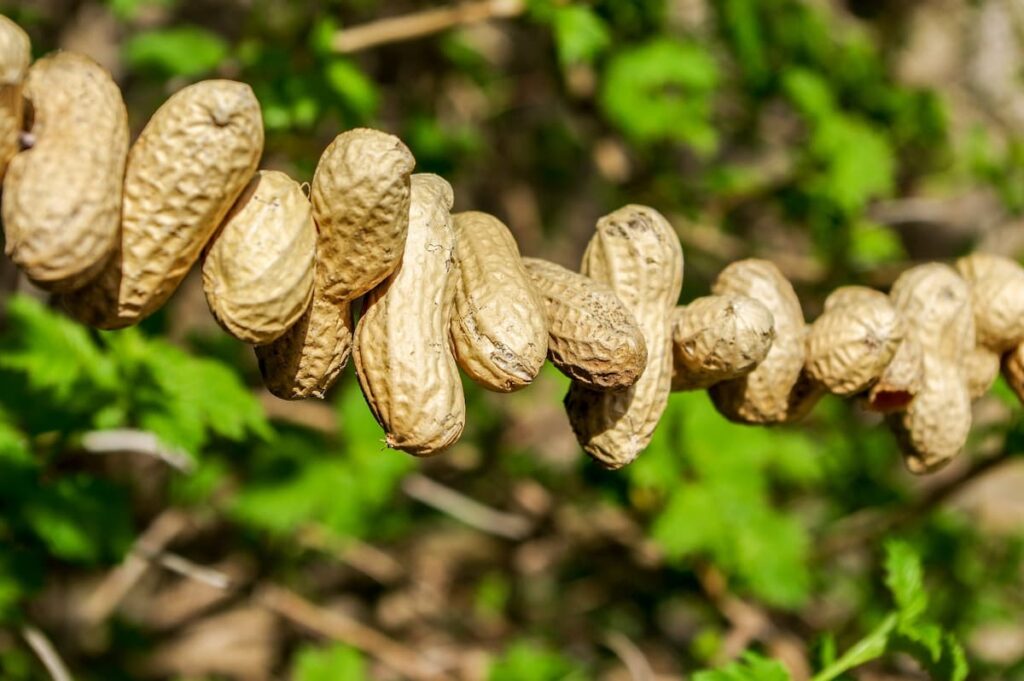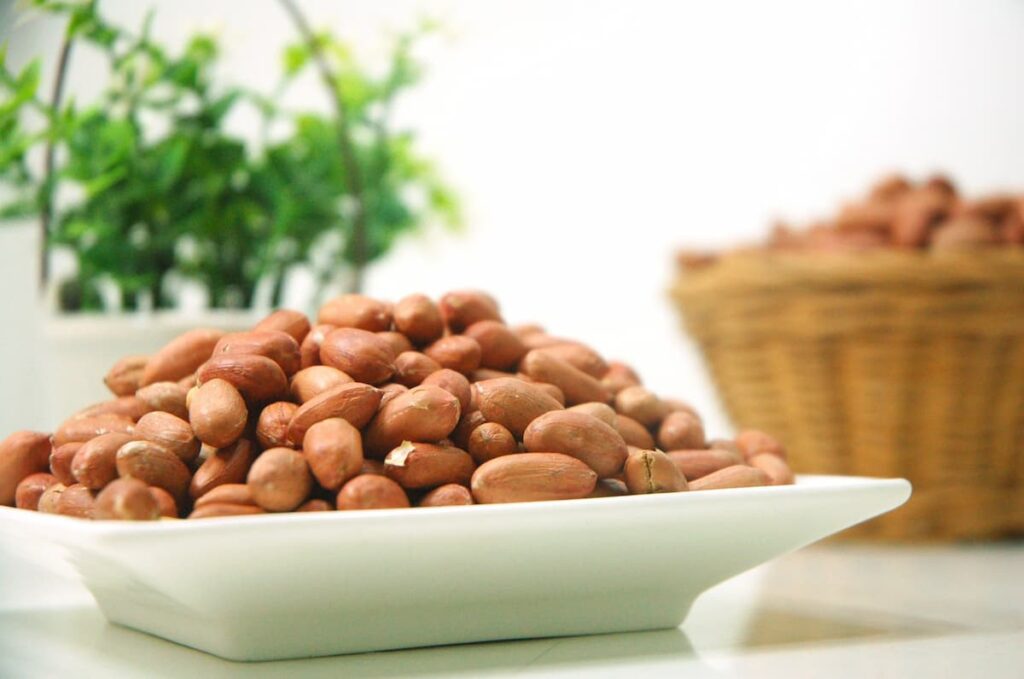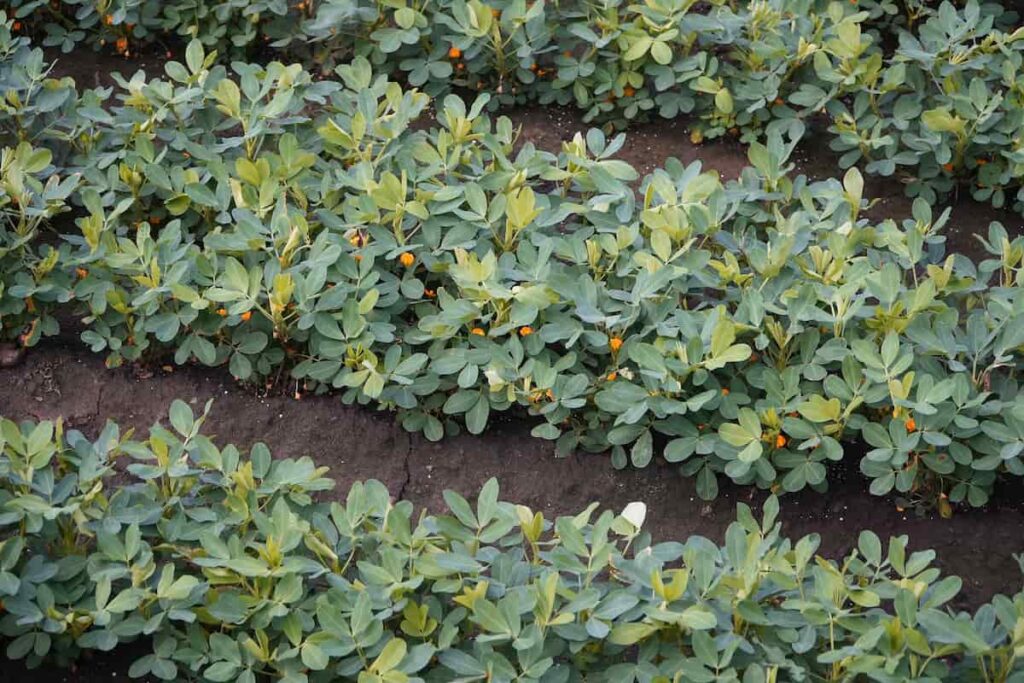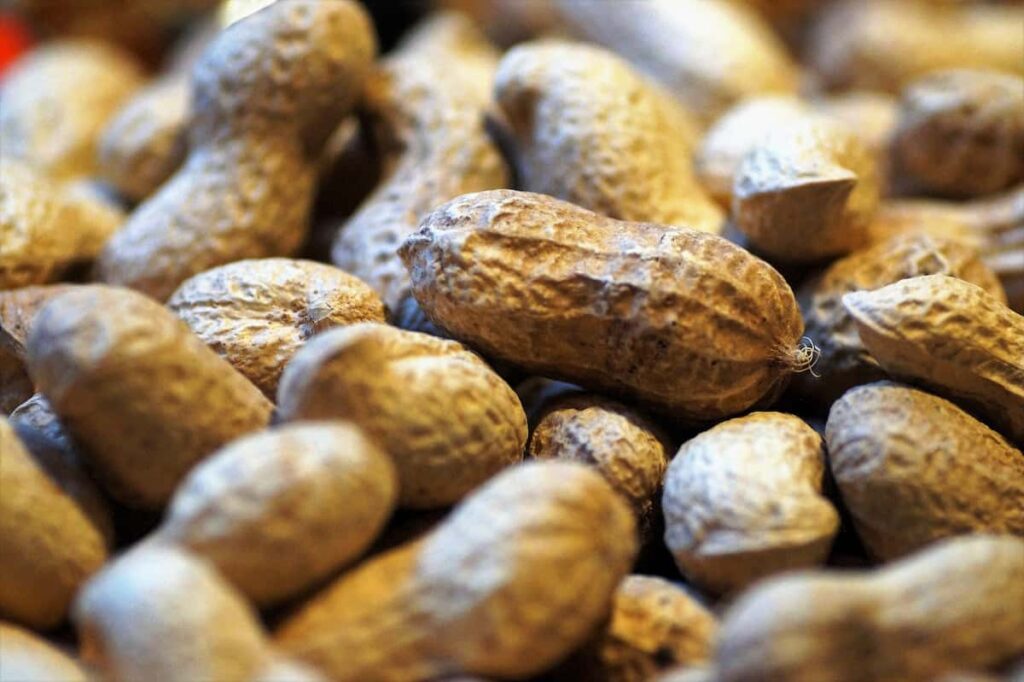The Peanut is a versatile and hardy legume that can be grown in various climates and soil types. Peanuts are relatively easy to grow and have a high yield potential. Peanuts are a popular crop to grow in raised beds. They are easy to grow and don’t require much space. Peanuts also have a high yield so you can get many Peanuts from a small area. Peanuts can be grown on raised beds in India. Let’s check out how to grow Peanuts in raised beds below.

Raised beds offer several advantages for Peanut cultivation, including improved drainage, aeration, and root development. They also make it easier to control weeds and pests. Peanuts grown on raised beds produce higher yields than those grown in traditional field conditions. They are widely cultivated in tropical and subtropical regions, including India. Peanuts are an excellent crop to grow on raised beds because they are less likely to be damaged by flooding and have better drainage.
They also require less fertilizer and pesticides than other crops. Raised beds are ideal for growing Peanuts due to their numerous benefits. First, raised beds to improve drainage and prevent waterlogging, a common problem in India. Second, raised beds to allow for better air circulation, which is essential for Peanut plants. Third, raised beds to make it easier to control the soil quality and fertilization of the plants. Finally, raised beds can help protect plants from pests and diseases.
How to grow Peanuts in raised beds
Peanut varieties suitable for raised bed cultivation
Regarding Peanuts, various types can be grown in raised beds. You should choose a Peanut variety suited to your area’s climate and soil conditions for the best results. No matter what type of Peanut you choose to grow, make sure that you select a disease-resistant variety. Peanuts are susceptible to several diseases, including root rot and leaf spot. By choosing a disease-resistant variety, you can help reduce the risk of these problems occurring in your raised bed garden.
Climate suitable for growing Peanuts in raised beds in India
The climate requirements for growing Peanuts in raised beds are pretty specific. The soil temperature must be at least 21°C for the germination of the seeds. Once the plants have emerged, they can tolerate lower temperatures but need a minimum of 18°C to grow well. Peanuts are not frost-hardy, so raised beds provide an ideal microclimate for their growth.
In case you missed it: Types of Succulents in India – Indoor Succulents Perfect for Indian Climate

Regarding rainfall, Peanuts require around 45 to 60 centimeters per season, which is why they are often grown in regions with a monsoon climate. They can tolerate some drought conditions but will produce a lower yield under such conditions. Finally, Peanuts need around 100 to 120 days from planting to harvesting, so make sure to choose a variety that matures within this timeframe for your region.
Soil requirement for growing Peanuts in raised beds in India
To grow your Peanuts, you must start with a soil mix high in organic matter. Peanuts do best in a loamy sand type of well-drained soil with a pH of 6.0 to 7.0. Peanuts prefer soil pH between 6 and 7. You can amend it with sulfur or aluminum sulfate if you have too alkaline soil. To ensure that your Peanut plants have all the nutrients they need to thrive, have your soil tested for nitrogen, phosphorus, and potassium levels.
Peanuts are heavy feeders and will require additional nutrients if the levels in your soil are low. You can add compost or organic matter to raise nutrient levels naturally. Once you’ve amended your soil, it’s time to prepare your raised bed. If you use an existing raised bed, you should loosen the top 12 inches of soil. If starting from scratch, build your bed according to the desired dimensions and loosen the top 12 inches of soil. After loosening the topsoil, level it out and add 2 to 3 inches of organic matter.
Water requirement for growing Peanuts in raised beds in India
When growing Peanuts in raised beds, it is essential to water them regularly and deeply. Peanuts need at least 1 inch of water per week, and you should give more during hot, dry periods. If you can’t provide that much water yourself, consider installing a drip irrigation system or soaker hoses.
In India, Peanuts are traditionally grown in raised beds. Raised beds offer several advantages for Peanut production, including improved drainage, aeration, and warmer soil temperatures. If rainfall is insufficient, supplemental irrigation will be necessary. Drip irrigation is the best method for watering Peanuts and can help to minimize disease problems.
In case you missed it: Grow Bag Size Chart in India: For Vegetables, Herbs, and Fruits

Raised bed size for growing Peanuts in India
The size of the raised bed for growing Peanuts should be at least 4X8 feet. If you have the space, you can make it even larger. The soil in the bed should be loose and well-drained. To help with drainage, you can add some sand to the soil. Peanuts need much space to grow, so make sure the bed is big enough. The best-raised bed material for growing Peanuts in India is a mix of 50% sand and 50% loam. This mix provides good drainage while retaining enough moisture for the Peanut plants. Peanuts do not like waterlogged, so the raised bed should have good drainage.
Growing Peanuts in the raised bed
If you want to grow Peanuts in raised beds, there are a few things you need to know. You should plant Peanuts in early spring after all the risk of frost has passed. Peanuts need well-drained, sandy soil with a pH of 6.0-7.0. They also need full sun and at least six hours of direct sunlight daily. You can either start with seedlings or sow seeds directly into the soil. If you’re using seedlings, plant them about 6 inches apart. If you’re sowing seeds, plant them about 1 inch apart and cover them lightly with soil.
Water the bed well and keep it moist until the Peanut plants emerge. Once they’ve emerged, reduce watering to once or twice a week, so the plants don’t get too wet. Peanuts need full sun to thrive, so make sure the bed is in a sunny spot. Also, give them plenty of room to spread out as they grow. When the plants are about 6 inches tall, thin them so that only the strongest plants are left growing. Peanuts will begin germinating in 7 to 10 days and should be ready to harvest in 110 to 120 days.
Transplanting Peanuts seedlings in the raised bed
It is advisable to transplant Peanut seedlings in raised beds after the last frost in your area. Peanuts require well-drained, loose, and sandy soils with pH 6.0 to 7.0 for optimal growth. You can use a garden tiller to loosen the soil in your raised bed before planting. Water the raised bed thoroughly a few days before you transplant the seedlings. This will help the roots take hold when transplanted.
Be careful when planting in the hole and cover it with loose soil, tamping down lightly around the base of the plant. Water immediately after transplanting keeps the soil moist but not soggy throughout the growing season. Peanuts are susceptible to drought stress, so make sure to water regularly during dry spells.
In case you missed it: Best Plants For Raised Bed Gardens

Fertilizer requirement for growing Peanuts in the raised bed in India
Regarding fertilizing Peanuts in raised beds, there are a few things to remember. Peanuts are heavy feeders that need a steady supply of nutrients throughout the growing season. If you’re using organic fertilizer, ensure it is correctly composted before applying it to your Peanut plants. It’s important to fertilize your Peanuts early in the season before they begin to flower. Apply fertilizer around each plant’s base, careful not to get any on the leaves or stems. Water the fertilizer into the soil well.
Continue to fertilize every four weeks or so throughout the growing season. A good fertilizer for Peanuts should also have a slightly acidic pH, which will help the plant uptake nutrients more effectively. Peanuts do not require much fertilizer, so it is essential to do it sparingly. Too much fertilizer can damage plants and reduce yields. If you are growing Peanuts in a raised bed, it is best to apply the fertilizer at planting time and then top dress with a light layer of compost or manure every few months.
Pruning for Peanuts
Peanuts are a legume, and like all legumes, they have nodules on their roots that fix nitrogen in the soil. This means that they don’t require as much nitrogen fertilizer as other crops, but it also means that they can be susceptible to nitrogen deficiency if not pruned properly. The best time to prune your Peanuts is when they are around 6-8 inches tall and have started to produce flowers. You should cut off the main stem about 2 inches above the soil line at this stage.
This will encourage the plant to produce more lateral branches, increasing yields. You can also remove any yellow or dead leaves from the plant at this time. After cutting the main stem, wait a few weeks and carefully prune each lateral branch back by about half. This will encourage more branching and help the plant produce more Peanuts. Once the Peanut pods have started to form, you can stop pruning altogether.
In case you missed it: Vegetable Spacing in the Raised Bed Garden

Pest and diseases of Peanuts in the raised bed
Pests are a common problem when growing Peanuts on raised beds. Various pests can attack Peanuts, including aphids, whiteflies, and caterpillars. Peanuts are also susceptible to fungal diseases such as root rot and leaf spot. Good sanitation and pest management practices are the best way to control Peanut pests. Be sure to remove any dead or infected plants from the bed immediately. You can also try using floating row covers or insecticidal soap to keep pests from getting to your plants.
The most common disease of Peanuts is a root-knot nematode. It is a soil-borne pest that feeds on the roots of the Peanut plant, causing them to become deformed and stunted. To control root-knot nematode, it is important to rotate crops, use resistant varieties, and practice good sanitation. Early leaf spots can be controlled with fungicides. Another disease that can affect Peanuts is botrytis gray mold. This fungal disease affects the flowers and fruits of the Peanut plant, causing them to rot. Botrytis gray mold can be controlled with fungicides as well.
Peanut harvesting season in India
The harvesting of Peanuts typically takes place between August and October, depending on the variety. Peanuts mature when the plants turn yellow and the nuts begin to drop from the pods.
Harvesting of Peanuts
To harvest Peanuts, loosen the soil around the plant with a spade or hoe. Then, using your hands or a small tool, carefully lift the plant from the ground, careful not to damage the roots. Next, shake off any excess dirt and spread the plants in a single layer on a tarp or other surface to dry for several days. Once they are dry, remove the Peanut pods from the plants, and store them in a dry place until you are ready to use them.
In case you missed it: How to Grow Turtle Vine Plant: Soil, Propagation, Planting, and Care

The yield of Peanuts in the raised bed in India
The yield of Peanuts in raised beds in India can be quite high, especially if the raised bed is well managed. Peanuts are relatively easy to grow and do not require many inputs. You can expect to harvest about 1,500 kg per hectare with proper management.
Conclusion
Peanuts are a versatile and delicious legume used in various dishes. They are relatively easy to grow and can be grown in raised beds in India. Growing Peanuts in raised beds in India is an excellent idea if you want to increase your yield. Peanuts are a drought-tolerant crop, so they will do well in raised beds that are slightly elevated. If you follow the steps mentioned above, you should be able to grow healthy and bountiful Peanuts in raised beds in India.
- How to Grow Hibiscus from Flower
- Plantation Ideas for Home Decoration: A Beginners Guide
- Flower Garden Designs and Layouts for Beginners
- Planting and Spacing Techniques in Papaya: A Beginner’s Guide
- Growing Gold: Essential Techniques for Planting Pineapples
- How to Make Kalanchoe Plant Bushy: Home Remedies and Solutions
- 11 Reasons Why Your Gardenia is Not Blooming: Home Remedies and Solutions
- Eco Elegance: The Guide to Designing a Drought-Tolerant Landscape
- Gardening on a Slope: Strategies for Hillside Landscaping
- Nourish and Flourish: Top Organic Mulches for Thriving House Plants
- Everything You Want to Know about Indian Mogra Flower: Discover Uses and Growing
- Green Thumb Success: Expert Tips for Cultivating Greenhouse Pumpkins All Year Round
- Maximize Growth & Flavor: The Ultimate Guide to Companion Planting in Herb Gardens
- How to Control Rhododendron Problems Naturally: Home Remedies and Organic Ways to Fix Them
- Natural Magic: The Remarkable Benefits of Cinnamon for Plants
- Best Steps to Revive Dying Tulip with Natural and Organic Treatment
- 10 Reasons Why Your Angel Trumpet is Not Blooming: Remedies and Treatment
- How to Fix Periwinkle Leaf and Flower-Related Problems: Natural Remedies and Solutions
- How to Fix Zinnias Leaf and Flower Problems: Discover Natural and Home Remedies
- Organic Steps to Induce Lemon Tree Flowers: A Comprehensive Guide
- Bloom Booster: Crafting the Perfect Homemade Bougainvillea Fertilizer
- Optimizing Growth: A Guide to Applying NPK Fertilizer for Potted Plants
- 10 Best Homemade Fertilizers for Rubber Plant: DIY Recipes and Application Method
- How to Boost Female Pumpkin Flowers: Effective Steps for More Flowers and High Yields
- Transform Your Indoor Garden: Top Benefits of Pink Salt for Houseplants
- 10 Best Homemade Fertilizers for Peacock Plants (Calathea): Easy DIY Guide
- Unlock Blooms: 9 Reasons Why Your Potted Chrysanthemum is Not Blooming
- 8 Reasons Why Your Potted Hibiscus is Not Blooming: Fix it with Simple Solutions
- Unlock Blooms: 9 Key Reasons Your Potted Frangipani Won’t Flower
- 10 Reasons Why Is My Ice Plant Not Blooming: Remedies and Treatment
- 10 Reasons Why My Potted Hydrangea Not Blooming: Treatment and Remedies
- 10 Reasons Why is My Wisteria Not Blooming: Remedies and Treatment
- 10 Reasons Why is My Goldfish Plant Not Blooming: Remedies and Treatment
- Maximize Your Space: Ultimate Guide to Balcony Gardening with Grow Bags
- 10 Reasons Why Your Iris is Not Blooming: Remedies and Treatment
- 10 Reasons Why Your Anthurium Plant is Not Blooming: Treatment and Remedies